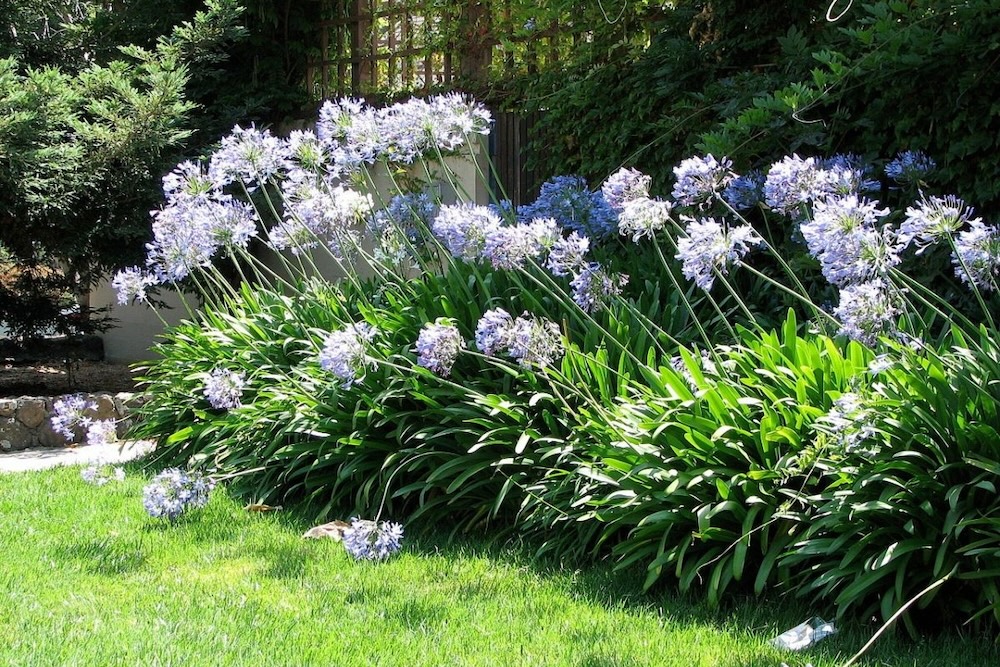Seasonal Agapanthus Treatment: Planning For Wintertime and Summertime
Seasonal Agapanthus Treatment: Planning For Wintertime and Summertime
Blog Article
Letting Loose the Secret to Successful Agapanthus Farming: Advice for a Flourishing Garden
In the realm of gardening, growing agapanthus efficiently calls for a strategic method that encompasses various elements of plant care. By recognizing the nuances of agapanthus growing, one can create an atmosphere where these plants prosper and bloom abundantly.
Growing Agapanthus: Best Practices
When growing Agapanthus, appropriate dirt prep work is crucial for guaranteeing successful growth and advancement of these beautiful blossoms. Agapanthus, typically referred to as Lily of the Nile or African lily, prospers in well-draining dirt with a somewhat acidic to neutral pH level - Agapanthus. Prior to growing, it is critical to amend hefty clay soils with natural matter such as garden compost or peat moss to boost water drainage and give vital nutrients for the plants
To plant Agapanthus, select an area that obtains full sunshine to partial color, as this will promote healthy and balanced growth and abundant blooming. Dig an opening twice the diameter of the plant's origin sphere and position the Agapanthus at the very same depth it was previously growing. Carefully backfill the opening with dirt, pushing down securely to eliminate any type of air pockets around the origins.
Water the recently grown Agapanthus thoroughly and continue to keep the dirt uniformly wet, especially throughout the plant's active growing period. Agapanthus. Using a well balanced fertilizer once a month can further support the plant's growth and flowering. By following these ideal methods for planting Agapanthus, you can produce a spectacular display screen of these captivating blossoms in your garden
Suitable Soil Conditions for Agapanthus
For optimal development and growing success of Agapanthus plants, making sure the dirt problems are perfect is important. Agapanthus prospers in well-draining dirt with a slightly acidic to neutral pH degree ranging from 6.0 to 7.0. This kind of soil enables appropriate water drainage, preventing waterlogging which can result in root rot. To improve dirt drainage, consider including organic matter such as compost or peat moss when preparing the growing website. Moreover, Agapanthus prefers soil that is rich in nutrients, so including a well balanced plant food throughout the growing period can promote healthy development and lively flowers.

Watering and Fertilizing Tips
To guarantee healthy and balanced growth and lively blossoms, correct watering and feeding methods are necessary for successful Agapanthus farming. click this link Agapanthus plants profit from regular watering, specifically during the growing period.
When it comes to feeding Agapanthus, a balanced plant food with equivalent components nitrogen, phosphorus, and potassium can be used in the springtime to advertise healthy growth and blooming. Slow-release plant foods are suitable for giving nutrients progressively over an extensive period. Avoid over-fertilizing, as this can bring about too much foliage growth at the expense of blooms.
In addition, integrating raw material like garden compost into the dirt can boost nutrient degrees and boost soil structure, assisting in the total health of the Agapanthus plants. By following these watering and feeding ideas, gardeners can ensure their Agapanthus plants prosper and produce spectacular screens of blossoms.
Trimming and Deadheading Methods
Appropriate pruning and deadheading strategies play a critical duty in keeping the health and aesthetic appeals of Agapanthus plants, complementing the necessary practices of watering and feeding for effective farming. Pruning Agapanthus includes getting rid of spent flower heads, dead or yellowing leaves, and general shaping of the plant to promote far better growth. Deadheading, the process of getting rid of discolored flowers, not just enhances the plant's appearance yet also encourages more blooming.
When deadheading click this site Agapanthus, it is advisable to clip off the blossom stem at the base using sharp, clean shears. This process reroutes the plant's energy from seed manufacturing back into origin and vegetation development, advertising a healthier and a lot more durable plant. Regular deadheading can prolong the blooming duration of Agapanthus and stop self-seeding, which can bring about congestion.
In terms of trimming, Agapanthus generally benefits from a light trim after flowering to clean the plant and encourage fresh growth. Cutting down the spent blossom stems and getting rid of any type of damaged or dead foliage assists preserve the plant's vitality and overall look. Nonetheless, it is vital to avoid cutting right into the crown of the plant, as this can damage its wellness.

Protecting Agapanthus From Pests and Diseases
Implementing efficient pest and illness monitoring techniques is critical to securing the wellness and vitality of Agapanthus plants in farming. One common bug that impacts Agapanthus is the Agapanthus borer, a caterpillar that passages right into the plant, causing damage to the blossoms and leaves.
In addition to insects, Agapanthus are prone to illness such as root rot and fungal fallen leave places. By remaining attentive and resolving parasite and disease issues quickly, gardeners can help their Agapanthus thrive and grow.

Conclusion
To conclude, successful growing of agapanthus needs appropriate planting techniques, ideal dirt conditions, ample watering and fertilizing, normal pruning and deadheading, and defense from illness and parasites. By adhering to these techniques and pointers, gardeners can guarantee a prospering yard filled up with attractive agapanthus flowers. Agapanthus. Bear in mind to keep regular care and interest to information to go to website advertise the health and longevity of these spectacular plants
When planting Agapanthus, correct dirt prep work is important for making sure effective development and development of these lovely blossoms.Water the freshly grown Agapanthus extensively and proceed to maintain the soil evenly wet, specifically throughout the plant's energetic expanding period.For optimum development and growing success of Agapanthus plants, making certain the soil conditions are optimal is vital. When hair transplanting or planting Agapanthus, make certain the soil is well-prepared to give the needed structure for the plants to establish themselves effectively. One common bug that influences Agapanthus is the Agapanthus borer, a caterpillar that passages right into the plant, creating damages to the leaves and blossoms.
Report this page